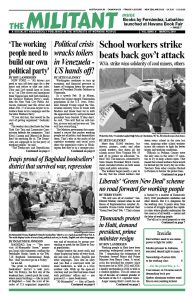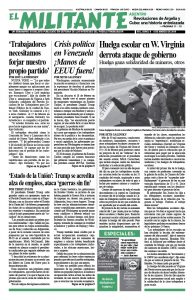At least 24 rail workers died on the job in 2018 in North America. We are now into the sixth week of 2019 and at least four rail workers have been killed on the job — all because of the rail bosses’ drive for more profit.
The increase in workers’ deaths lies with rail bosses pushing greater train lengths with smaller and smaller crews, on schedules that dictate constant fatigue, often insufficient training and a boss-led culture of cutting corners. Profit-driven employers are pushing for more, even though they know perfectly well this causes increased dangers to crews and to those who live and work near rail lines.
My party, the Socialist Workers Party, says no worker has to die. Workers need to use union power to fight for control over working conditions and against the bosses’ speedup and harassment.
The latest fatalities came on a Canadian Pacific freight train in the early morning hours of Feb. 4. The three crew members — engineer Andrew Dockrell, conductor Dylan Paradis and conductor trainee Daniel Waldenberger-Bulmer — were killed when their train rolled down a steep grade and derailed in frigid conditions with failed air brakes near Field, British Columbia. The train carried 112 loaded grain hoppers. It weighed over 11,000 tons and was over 5,500 feet long. Only 13 rail cars were still on the track after the disaster.
Three days later Keith Gilmore, a Norfolk Southern conductor with only six months experience, was killed in a move in a Baltimore yard when he struck rail cars standing on an adjacent track.
Fight for workers control
When I hired out on the railroad in Lincoln, Nebraska, in 1960 crews were five strong and rail workers who trained me fought to use union power to control conditions on trains in the yard and on the road. I was educated by rail workers who learned from past generations who had won that power in battle.
I also had the chance to learn from a visit with Cuban rail workers in Havana some years ago. Workers that operate the trains in Cuba have five or more on a crew, seldom work at night and could not remember the last time a rail worker was killed or seriously injured on the job. That’s because they control conditions on the job, a result of the gains made by Cuban workers and working farmers making a revolution. They overthrew the bosses, replacing them with a workers and famers government based on social needs, not profits.
Most trains on the road when I started were no longer than 50 to 75 cars, approximately 2,000 to 3,000 feet in length. The conductor and a brake person were in the caboose at the end of the train. Their responsibility was to watch both sides of the train looking towards the head end and they had the power to “pull” the emergency air brake to stop the train if they saw a problem. By having a “rear end” crew, the workers could also help protect working people and working farmers and ranchers who worked or lived close by. Yard workers had similar size crews.
After years of attacks on workers and job conditions by the bosses, trains in North America today increasingly reach over 10,000 feet in length, some over 15,000 feet, and train weight can exceed 15,000 tons. More and more yard conductors work alone using a “Beltpack” for Remote Control Operation. Rail bosses run most trains now with two-person crews, both on the head end. They are pushing to run engineer-only trains. Their longer-term plan is to run with “automation” — eliminate an operating crew altogether — as they do now on some iron ore lines in Australia.
For decades top union officials in North America have followed a course of class collaboration, looking to the Democrats and Republicans to pass laws setting a minimum crew size of two workers and other government regulations to slow down the bosses’ push for one-person operations and automation.
Mobilize union power
The place to start today is to reverse that trend in our unions and fight on a different course.
We need to educate, organize, and mobilize the union, to explain that there is no solution for a safe workplace except what I was taught on the job by fellow rail workers in 1960 — to use union power and fight for workers control.
We should fight for no trains over 50 cars in length, with four-person crews, including two engineers on the locomotive and two workers on a caboose or engine on the rear. The increase in crew size and increase in trains will provide much needed jobs for thousands in hard-hit working-class communities across North America.
Rail workers have a social responsibility to fight to make their workplace safe not only for themselves, but for all those who live and work near the tracks.
And we must chart the course forward that Karl Marx outlined in “Trade Unions: Their Past, Present and Future.” He argued that unions “must now learn to act deliberately as organizing centers of the working class in the broad interest of its complete emancipation.” Adding, “They must convince the world at large that their efforts, far from being narrow and selfish, aim at the emancipation of the downtrodden millions.”
Joe Swanson worked 31 years on the railroad and is the Socialist Workers Party candidate for mayor of Lincoln, Nebraska.

